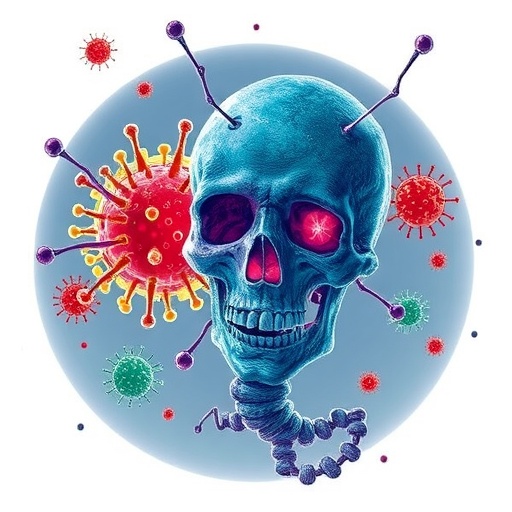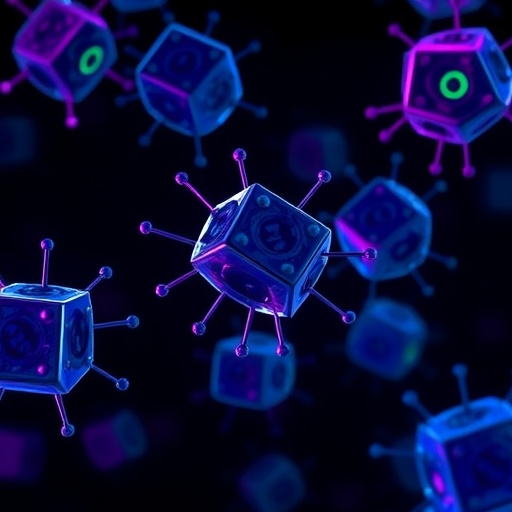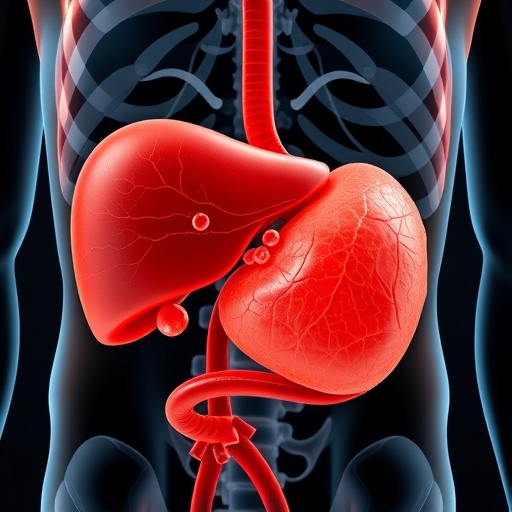
Cancer remains the most formidable disease-related killer among children worldwide, a plight exacerbated by the enigmatic mechanisms underpinning tumor development at the molecular level. Recent groundbreaking research has illuminated the pivotal role of circular extra-chromosomal DNA (ecDNA) in pediatric cancers, providing unprecedented insight into how these rogue genetic elements drive oncogene amplification and tumor heterogeneity. Unlike traditional genomic DNA housed linearly within chromosomes, ecDNA comprises circular DNA fragments that have been excised from chromosomes and aberrantly reassembled via DNA repair pathways, enabling them to exist and replicate independently within cancer cells.
The presence of these ecDNA entities in cancer cells presents a formidable biological challenge: they carry oncogenes—genes promoting unchecked cellular proliferation—in amplified copies, effectively increasing the oncogenic dosage beyond the constraints imposed by chromosomal localization. This amplification leads to rapid tumor growth and heightened malignancy. In a paradigm-shifting study published in Cancer Discovery, an international consortium of scientists led by Lukas Chavez, PhD, from the Sanford Burnham Prebys Medical Discovery Institute, has elucidated how the prevalence and dynamic behavior of ecDNA alters the therapeutic landscape in neuroblastoma, a common childhood cancer.
Dr. Chavez and colleagues demonstrated that pediatric solid tumors harbor significantly more ecDNA than previously estimated, with these circular genetic elements tightly linked to poor clinical outcomes. The crux of their discovery lies in the observation that tumor cells possessing elevated copies of the oncogene MYCN on ecDNA grow aggressively but paradoxically exhibit heightened sensitivity to conventional chemotherapy regimens. This susceptibility likely stems from the metabolic and replicative stress burden that high oncogene dosage entails, rendering such cells vulnerable to cytotoxic agents.
.adsslot_O502icFCQr{width:728px !important;height:90px !important;}
@media(max-width:1199px){ .adsslot_O502icFCQr{width:468px !important;height:60px !important;}
}
@media(max-width:767px){ .adsslot_O502icFCQr{width:320px !important;height:50px !important;}
}
ADVERTISEMENT
Conversely, a subpopulation of tumor cells exhibits markedly fewer copies of MYCN ecDNA and enter a state of dormancy known as senescence—a zombie-like cellular condition characterized by an irreversible arrest in cell division but continued metabolic activity. These senescent cells evade chemotherapy-induced cell death, serving as a reservoir for relapse by re-entering the cell cycle months or even years following initial treatment. This mechanism offers a compelling explanation for the often vexing clinical phenomenon in neuroblastoma where initial remission is followed by eventual tumor recurrence.
The research team employed an integrative approach combining high-throughput genomic sequencing, functional biology experiments, and comprehensive drug screening to dissect the complexity of ecDNA dynamics and their impact on therapeutic response. Crucially, preclinical models involving neuroblastoma-bearing mice revealed that a combinatorial treatment strategy—merging standard chemotherapy with novel agents specifically targeting senescent cancer cells—yielded striking improvements in treatment efficacy and survival outcomes. This therapeutic synergy suggests a promising avenue to overcome relapse by eradicating the stubborn senescent cell populations that conventional chemotherapy leaves behind.
Further extending their findings beyond neuroblastoma, contributors such as Ashley Hui from the Chavez laboratory observed analogous ecDNA-associated senescence phenomena in medulloblastoma, the most prevalent malignant pediatric brain tumor. This revelation underscores the broader relevance of ecDNA dynamics across diverse tumor types and highlights the necessity of developing ecDNA-targeted therapies to improve pediatric oncology outcomes.
“We are uniquely positioned to leverage genomic insights into ecDNA architecture alongside innovative drug discovery platforms to target these oncogenic circles,” emphasizes Dr. Chavez. The integration of genomic analysis with hypothesis-driven functional experiments stands at the forefront of a new era in cancer biology, where deciphering the heterogeneity introduced by ecDNA could facilitate the identification of novel therapeutic targets.
From a mechanistic perspective, ecDNA evade conventional cell-cycle checkpoints and genomic surveillance, enabling them to rapidly adapt and rewire oncogenic signaling pathways. This plasticity translates into a formidable capacity for cancer cells to develop drug resistance and evade immune detection. Understanding the biogenesis of ecDNA and its role in oncogene dosage heterogeneity is thus paramount in unraveling treatment resistance and disease progression in pediatric malignancies.
The study’s comprehensive design entailed isolating ecDNA from tumor samples, quantifying oncogene copy numbers, and delineating the phenotypic consequences of ecDNA variance within heterogeneous tumor cell populations. Investigating these elements in vivo using murine models permitted an evaluation of combinatory therapeutic regimens, capturing the dynamic interplay between proliferative and senescent cancer cell populations over the course of treatment and relapse.
Beyond the immediate clinical implications, these findings carry profound relevance for basic cancer biology, highlighting ecDNA as a driver of intratumoral heterogeneity—a phenomenon long recognized as a major obstacle in effective cancer treatment. As ecDNA can shuffle oncogenes and regulatory elements independently of chromosomal constraints, they fuel rapid evolutionary adaptation, making tumor eradication an elusive goal with standard monotherapies.
In the wider scientific and medical communities, this research marks a pivotal step towards personalized medicine approaches that account for ecDNA-driven genetic diversity. By tailoring treatments that concurrently target both the chemosensitive high-oncogene ecDNA-bearing cells and the usually refractory senescent populations, clinicians may improve long-term remission rates for vulnerable pediatric patients.
Looking forward, the promise of next-generation drug screens aligned with ecDNA biology heralds an exciting frontier. Companion diagnostics capable of detecting ecDNA status could guide clinicians in real time to adopt combination therapies optimized to eliminate these adaptable cancer cell populations. Such advances serve as a beacon of hope for children afflicted by aggressive brain tumors and other solid cancers, where conventional therapies often fall short.
The synergy between multidisciplinary research teams across institutions including Sanford Burnham Prebys, Charité Berlin, Queen Mary University of London, and Sun Yat-sen University fuels this crucial progress. Supported by numerous national and international funding agencies, the collaborative ethos exemplifies the determination to translate genetic discoveries into tangible therapeutic breakthroughs that will ultimately save young lives.
As Dr. Chavez eloquently remarks, “Our ultimate aim is to convert scientific insights into more effective therapies and durable cures for children with brain cancer.” The relentless pursuit of understanding ecDNA’s role in cancer pathogenesis is poised to redefine treatment paradigms and dramatically improve pediatric oncology outcomes in the years to come.
Subject of Research: Animals
Article Title: Extrachromosomal DNA-Driven Oncogene Dosage Heterogeneity Promotes Rapid Adaptation to Therapy in MYCN-Amplified Cancers
News Publication Date: 7-Aug-2025
Web References:
https://doi.org/10.1158/2159-8290.CD-24-1738
Image Credits: Sanford Burnham Prebys
Keywords: Brain cancer; Neuroblastoma; Cancer genomics; Carcinogenesis; Cancer genome sequencing; Cancer proliferation genes; Oncogenes; Cancer medication; Chemotherapy; Cellular senescence; Senescence
Tags: biological challenges of ecDNA in cancerchallenges in treating pediatric solid tumorschemotherapy resistance in pediatric cancercircular extra-chromosomal DNA in tumorsDr. Lukas Chavez research findingsimplications of ecDNA for cancer therapymechanisms of cancer cell dormancyoncogene amplification in neuroblastomapediatric cancer research advancementsrole of circular DNA in cancer progressiontumor growth factors in neuroblastomatumor heterogeneity in childhood cancers





